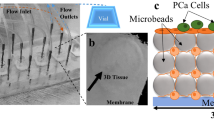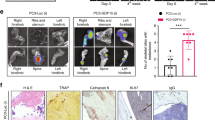Abstract
Bone is the preferred site for prostate cancer (PCa) metastases. Once the tumor has established itself within the bone there is virtually no cure. To better understand the interactions between the PCa cells and bone environment in the metastatic process new model systems are needed. We have established a two-compartment in vitro co-culturing model that can be used to follow the trans-activation of bone and/or tumor cells. The model was validated using two PCa tumor cell lines (PC-3; lytic and LNCaP; mixed/osteoblastic) and one osteolytic inducing factor, 1,25-dihydroxyvitamin D3 (D3). Results were in accordance with the expected bone phenotypes; PC-3 cells and D3 gave osteolytic gene expression profiles in calvariae, with up-regulation of genes needed for osteoclast differentiation, activation and function; Rankl, CathK, Trap and MMP-9, and down-regulation of genes associated with osteoblast differentiation and bone mineralization; Alp, Ocl and Dkk-1. LNCaP cells activated genes in the calvarial bones associated with osteoblast differentiation and mineralization, with marginal effects on osteolytic genes. The results were strengthened by similar changes in protein expression for a selection of the analyzed genes. Furthermore, the osteolytic gene expression profiles in calvarial bones co-cultured with PC-3 cells or with D3 were correlated with the actual ongoing resorptive process, as assessed by the release of collagen fragments from the calvariae. Our results show that the model can be used to follow tumor-induced bone remodeling, and by measuring changes in gene expression in the tumor cells we can also study how they respond to the bone microenvironment.





Similar content being viewed by others
Abbreviations
- ACTB:
-
β-Actin
- ALP:
-
Alkaline phosphatase
- CATHK:
-
Cathepsin K
- CTX-I:
-
C-terminal telopeptide fragments of type I collagen
- D3:
-
1,25-Dihydroxyvitamin D3
- DKK-1:
-
Dickkopf-1
- ET-1:
-
Endothelin 1
- ETA:
-
Endothelin receptor A
- IGF-1:
-
Insulin-like growth factor type 1
- IGF-R1:
-
Insulin-like growth factor type 1 receptor
- MMP-9:
-
Matrix metalloproteinase 9
- OCL:
-
Osteocalcin
- OPG:
-
Osteoprotegerin
- PCa:
-
Prostate cancer
- PCR:
-
Polymerase chain reaction
- PSA:
-
Prostate specific antigen
- PTHRP:
-
Parathyroid hormone-related protein
- RANK:
-
Receptor activator of nuclear factor-κB
- RANKL:
-
Receptor activator of nuclear factor-κB ligand
- RPL13:
-
Ribosomal protein L13
- TGF-β1:
-
Transforming growth factor β 1
- TRAP:
-
Tartrate-resistant acid phosphatase
References
Carlin BI, Andriole GL (2000) The natural history, skeletal complications, and management of bone metastases in patients with prostate carcinoma. Cancer 88:2989–2994. doi:10.1002/1097-0142(20000615)88:12+<2989:AID-CNCR14>3.0.CO;2-Q
Pentyala SN, Lee J, Hsieh K et al (2000) Prostate cancer: a comprehensive review. Med Oncol 17:85–105
Mundy GR (2002) Metastasis to bone: causes, consequences and therapeutic opportunities. Nat Rev Cancer 2:584–593. doi:10.1038/nrc867
Robinson VL, Kauffman EC, Sokoloff MH (2004) The basic biology of metastasis. In: Keller ET, Chung LW et al (eds) The biology of skeletal metastases. Kluwer Academic Publishers, Norwell, pp 1–21
Bussard KM, Gay CV, Mastro AM (2008) The bone microenvironment in metastasis; what is special about bone? Cancer Metastasis Rev 27:41–55. doi:10.1007/s10555-007-9109-4
Tu S-M, Lin S-H (2004) Clinical aspects of bone metastases in prostate cancer. In: Keller ET, Chung LW (eds) The biology of skeletal metastases. Kluwer Academic Publishers, Norwell, pp 23–46
Lerner UH (2006) Bone remodeling in post-menopausal osteoporosis. J Dent Res 85:584–595
Boyle WJ, Simonet WS, Lacey DL (2003) Osteoclast differentiation and activation. Nature 423:337–342. doi:10.1038/nature01658
Stein GS, Lian JB (1993) Molecular mechanisms mediating proliferation/differentiation interrelationships during progressive development of the osteoblast phenotype. Endocr Rev 14:424–442
van der Horst G, van der Werf SM, Farih-Sips H et al (2005) Downregulation of Wnt signaling by increased expression of Dickkopf-1 and -2 is a prerequisite for late-stage osteoblast differentiation of KS483 cells. J Bone Miner Res 20:1867–1877. doi:10.1359/JBMR.050614
Kearns AE, Khosla S, Kostenuik PJ (2008) Receptor activator of nuclear factor kappaB ligand and osteoprotegerin regulation of bone remodeling in health and disease. Endocr Rev 29:155–192. doi:10.1210/er.2007-0014
Corey E, Quinn JE, Bladou F et al (2002) Establishment and characterization of osseous prostate cancer models: intra-tibial injection of human prostate cancer cells. Prostate 52:20–33. doi:10.1002/pros.10091
Thalmann GN, Sikes RA, Wu TT et al (2000) LNCaP progression model of human prostate cancer: androgen-independence and osseous metastasis. Prostate 44:91–103
Teitelbaum SL (2000) Bone resorption by osteoclasts. Science 289:1504–1508
Kaighn ME, Narayan KS, Ohnuki Y et al (1979) Establishment and characterization of a human prostatic carcinoma cell line (PC-3). Invest Urol 17:16–23
Horoszewicz JS, Leong SS, Kawinski E et al (1983) LNCaP model of human prostatic carcinoma. Cancer Res 43:1809–1818
Lerner UH (1987) Modifications of the mouse calvarial technique improve the responsiveness to stimulators of bone resorption. J Bone Miner Res 2:375–383
Barrett JM, Rovedo MA, Tajuddin AM et al (2006) Prostate cancer cells regulate growth and differentiation of bone marrow endothelial cells through TGFbeta and its receptor, TGFbetaRII. Prostate 66:632–650. doi:10.1002/pros.20370
Nyambo R, Cross N, Lippitt J et al (2004) Human bone marrow stromal cells protect prostate cancer cells from TRAIL-induced apoptosis. J Bone Miner Res 19:1712–1721. doi:10.1359/JBMR.040703
Guise TA, Mohammad KS, Clines G et al (2006) Basic mechanisms responsible for osteolytic and osteoblastic bone metastases. Clin Cancer Res 12:6213s–6216s. doi:10.1158/1078-0432.CCR-06-1007
Thomas RJ, Guise TA, Yin JJ et al (1999) Breast cancer cells interact with osteoblasts to support osteoclast formation. Endocrinology 140:4451–4458
Hall CL, Bafico A, Dai J et al (2005) Prostate cancer cells promote osteoblastic bone metastases through Wnts. Cancer Res 65:7554–7560. doi:10.1158/0008-5472.CAN-05-1317
Yin JJ, Selander K, Chirgwin JM et al (1999) TGF-beta signaling blockade inhibits PTHrP secretion by breast cancer cells and bone metastases development. J Clin Invest 103:197–206. doi:10.1172/JCI3523
Wang E, Wang J, Chin E et al (1995) Cellular patterns of insulin-like growth factor system gene expression in murine chondrogenesis and osteogenesis. Endocrinology 136:2741–2751
Linkhart TA, Mohan S, Baylink DJ (1996) Growth factors for bone growth and repair: IGF, TGF beta and BMP. Bone 19:1S–12S
Acknowledgments
This work was supported by grants from the Swedish Cancer Society (project no. 070604), the Swedish Medical Research Council (project no. 7525), The Royal 80 Year Fund of King Gustav V, the Norwegian Cancer Society, Lions Research Foundation and Umeå University, Sweden.
Author information
Authors and Affiliations
Corresponding author
Additional information
Annika Nordstrand and Jonas Nilsson contributed equally to this work.
Rights and permissions
About this article
Cite this article
Nordstrand, A., Nilsson, J., Tieva, Å. et al. Establishment and validation of an in vitro co-culture model to study the interactions between bone and prostate cancer cells. Clin Exp Metastasis 26, 945–953 (2009). https://doi.org/10.1007/s10585-009-9285-4
Received:
Accepted:
Published:
Issue Date:
DOI: https://doi.org/10.1007/s10585-009-9285-4




